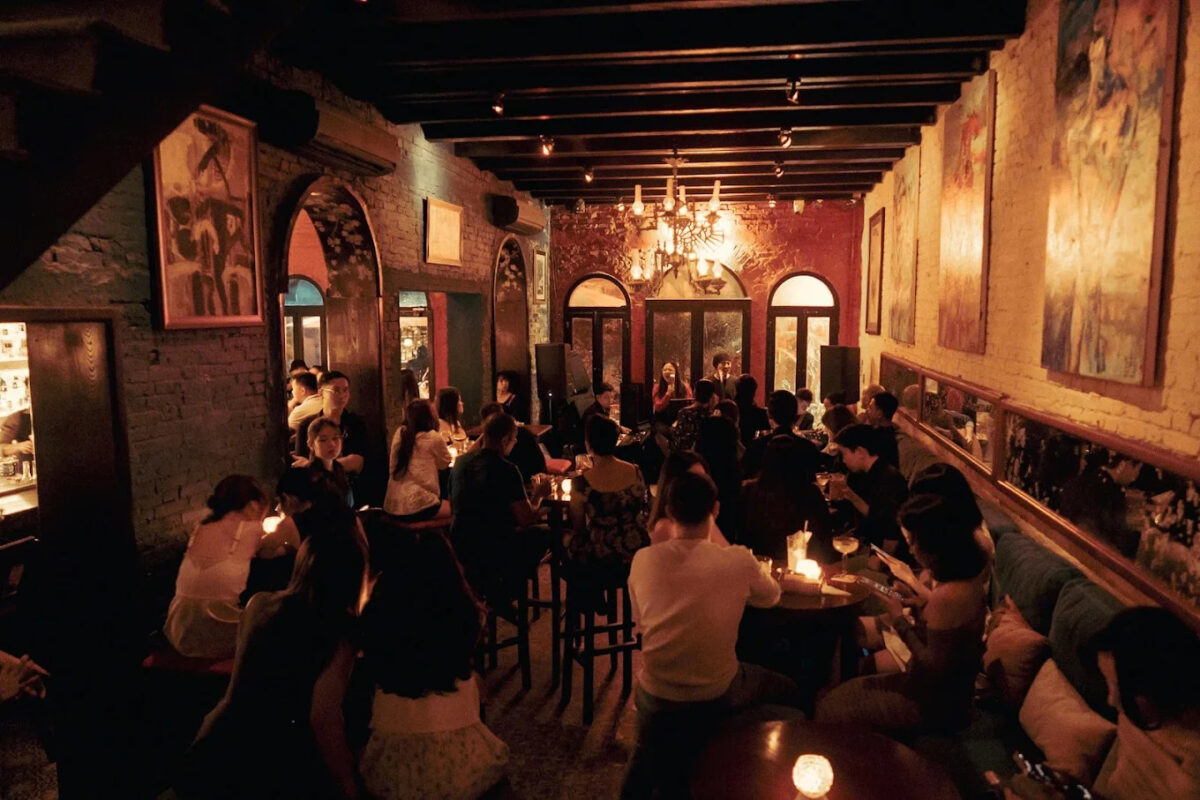Have you ever heard of floating markets? These vibrant, bustling markets, where sellers and buyers conduct business from boats along the river, are a truly unique and unforgettable cultural experience. Floating markets are a hallmark of Southeast Asia, but floating markets in Vietnam carry a distinct charm all their own. The hum of boat engines, the calls of traders advertising their goods, and the sight of colorful produce piled high on small boats create an atmosphere that’s unlike anything else.
When I first visited a floating market, I was struck by the sheer energy of the place. It was chaotic yet harmonious, and I couldn’t help but feel a deep admiration for the way people had adapted to life on the river. How do they manage to trade so efficiently without shops or streets? What are the most popular products sold in these markets? Join me as I dive into the story behind Vietnam’s floating markets and share what makes them so special.
The History of Floating Markets in Vietnam
Floating markets in Vietnam
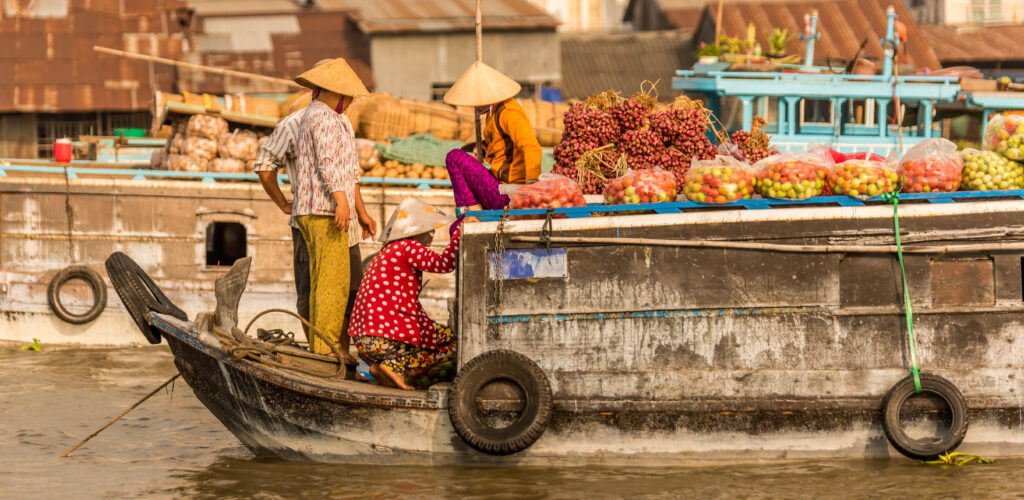
The origins of floating markets in Vietnam are shrouded in mystery, but their existence speaks volumes about human ingenuity and adaptability. According to MA. Tran at the Vietnam National Institute of Culture and Arts in Ho Chi Minh City, floating markets represent the locals’ profound connection to their natural environment. With an intricate network of rivers flowing through Southern Vietnam and roads that were once undeveloped, trading by boat became not just a necessity but a way of life. Over time, this river-based trade evolved into the iconic floating markets that still thrive today.
Standing on the banks of the Mekong Delta, watching the boats glide past, I couldn’t help but imagine the generations of traders who had passed through these waters before. It was as though the river carried with it the stories of all those who had come before, flowing steadily through time. The sight of people working together, passing goods from boat to boat, and shouting prices across the water filled me with a sense of awe. This wasn’t just a market—it was a living testament to the resilience and resourcefulness of the Vietnamese people.
What Makes Floating Markets in Vietnam Special?
Trading is Conducted Above the Water

As the name implies, floating markets in Vietnam involve all trading activities taking place directly on the water. This is what makes them stand out so vividly in comparison to regular markets on land. In most parts of the world, markets are bustling hubs located in town squares or streets, filled with the sounds of vendors shouting, people haggling, and goods changing hands. But in Vietnam, especially in the Mekong Delta, the markets have adapted to the rivers that weave through the region.
What’s truly fascinating is that boats, which are typically just modes of transportation on the water, take on an entirely different role in floating markets—they become the shops. Each boat is like a floating stall, filled with fruits, vegetables, seafood, and other goods. It’s impressive to watch the traders skillfully maneuver their boats through the crowded waterways, exchanging products with customers from boat to boat, all while keeping their balance on the gentle sway of the river.
When I first saw a floating market in action, it felt like I had stepped into another world. Seeing the boats loaded with fresh produce and hearing the vibrant conversations shouted across the water made me realize how creatively the people had adapted to their surroundings. The river, which for most is a barrier or a challenge, has become a thriving center of commerce in this part of the world. It was amazing to witness how something as ordinary as a boat could become the lifeblood of local trade.
Trading is Performed Flexibly
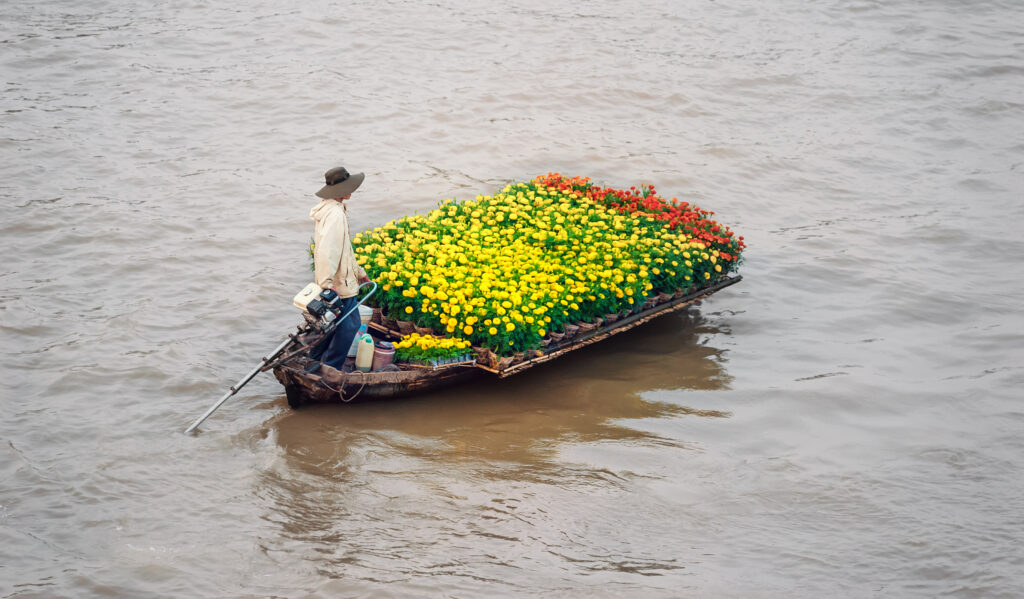
One of the most remarkable aspects of floating markets in Vietnam is the flexibility of the trade itself. While traditional markets have fixed stalls or shops, waiting for buyers to come, the “shops” in floating markets are constantly on the move. These shops are actually boats, loaded with goods like fruits, vegetables, and flowers, drifting along the river. Sellers don’t have the luxury of waiting for customers to walk by—they have to actively move their boats to find buyers. This dynamic nature of floating markets is what makes them so unique and lively.
Because the boats are always in motion, traders have developed a distinctive way of advertising their products. One fascinating aspect is the use of the Beo tree, a bamboo pole mounted on the boat, where sellers hang samples of their goods, such as bunches of bananas or vibrant flowers. The Beo tree acts like a floating billboard, allowing buyers to see what’s for sale from a distance, even as the boats drift by. This creative form of advertising not only draws attention but also respects the serene nature of the river market, offering a quiet and clever solution to the challenges of trading on the water.
When I first saw the Beo tree in action, I was struck by the ingenuity of it. It’s a simple yet effective way for sellers to showcase their goods, and it adds to the charm of the floating markets. Watching the colorful fruit and produce hanging from the poles, swaying gently as the boats passed by, I could see how this early form of advertising has become an integral part of the merchant business culture in the Mekong Delta. It was a perfect example of how these markets have adapted to the river environment, blending practicality with tradition in a way that feels timeless.
Floating Markets Are Cosmopolitan
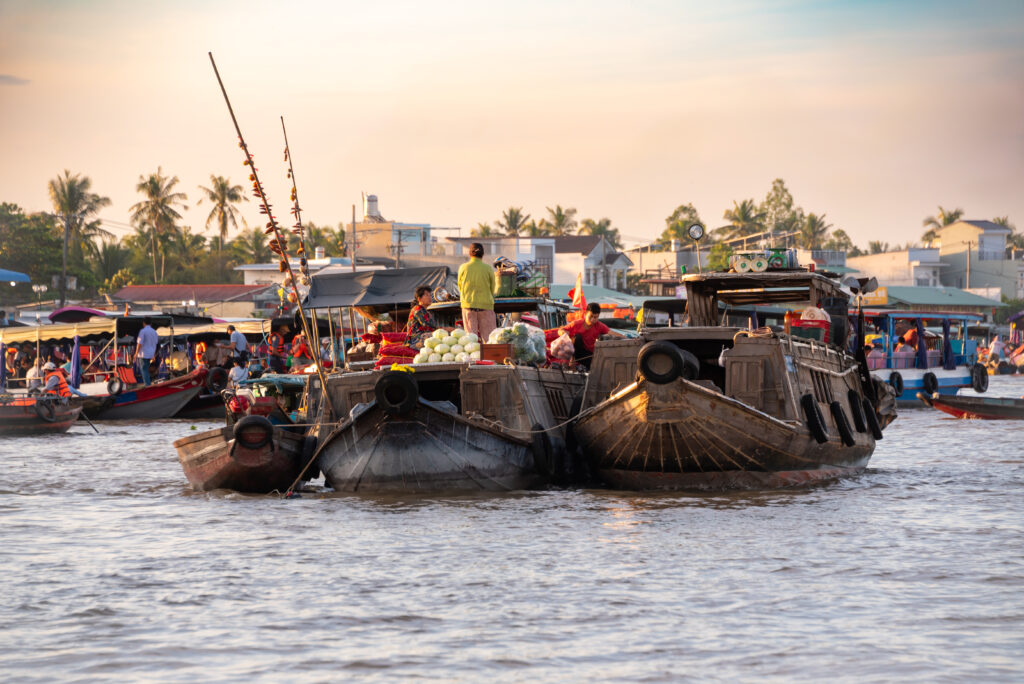
Another fascinating aspect of floating markets in Vietnam is their cosmopolitan nature. Unlike local land markets where sellers and buyers are usually from nearby areas, floating markets bring together traders from many different provinces and regions. These markets are often located at the points where river branches meet, serving as hubs for people from various parts of the country. This diversity is reflected in the wide variety of goods sold on the boats, from local fruits and vegetables to specialties unique to different regions of Vietnam.
The result is a vibrant and colorful scene where boats are filled with products representing the rich diversity of Vietnam’s culture and cuisine. From the tropical fruits of the Mekong Delta to specialty goods from more remote areas, the floating market becomes a melting pot of different traditions and flavors. It’s not just a place for trading goods—it’s a space for cultural exchange as well.
When I visited a floating market for the first time, I was amazed by the variety of products on display. I could spot everything from freshly harvested coconuts and durians to rare herbs and spices from different regions. It was like witnessing the entire country’s agricultural bounty come together on one river. But what struck me the most was how the floating markets not only facilitated trade but also fostered connections between people from all walks of life. Each boat carried not just products but a story, a tradition, or a cultural element from another part of Vietnam, making the floating market a unique blend of commerce and cultural richness.
Garden Fruits Are the Main Goods of Floating Markets
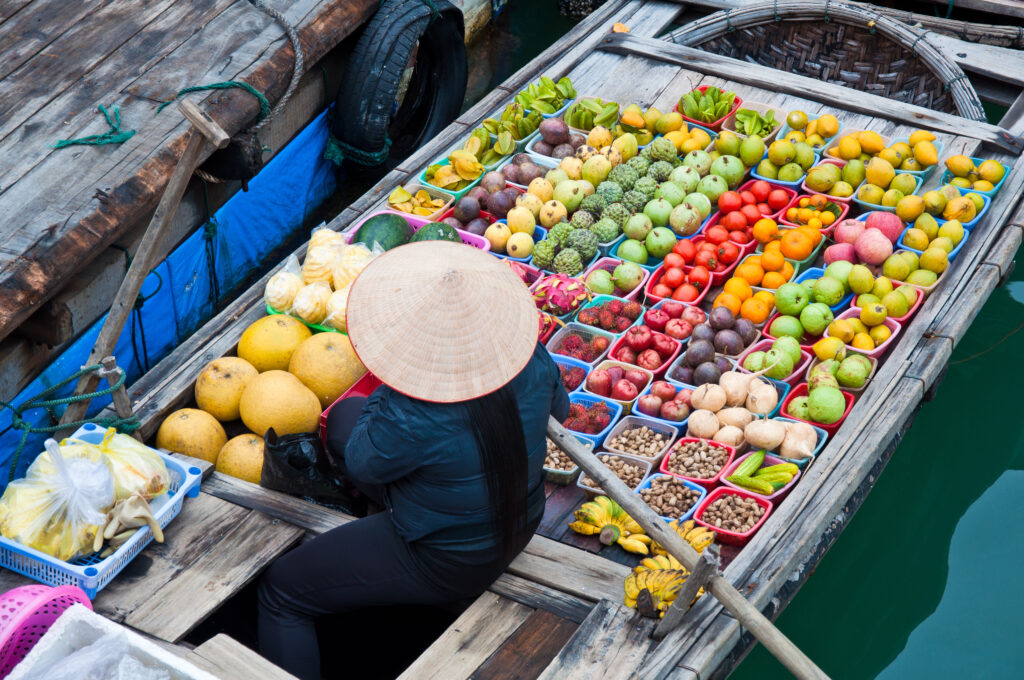
One of the most distinctive features of floating markets in Vietnam is the abundance of garden fruits, which are the main goods traded on the rivers. This reflects the agricultural richness of Southern Vietnam, where the fertile soil, nourished by river illuvium, and the favorable climate create the perfect conditions for fruit cultivation. The region’s land is not only ideal for wet rice farming but also for growing a wide variety of fruits, making them a vital part of the local economy.
At the floating markets, you will find boats overflowing with vibrant, fresh fruits—everything from juicy mangoes, rambutan, and longan to exotic dragon fruit, jackfruit, and durian. The diversity and freshness of the fruits being sold are a testament to the agricultural prosperity of the Mekong Delta region. For many of the traders, their livelihood depends on selling these fruits, which are harvested from the vast orchards that dot the landscape.
During my visit to a floating market, the sight of the colorful boats brimming with fruits was truly mesmerizing. The sweet aroma of ripened fruit mixed with the cool morning air of the river made the experience unforgettable. Each boat was a moving orchard, offering the best of what the region had to offer. The sheer variety of fruits being sold not only highlights the natural bounty of the area but also reflects the deep connection between the people and their agricultural roots. In many ways, the floating markets are a living showcase of the Southern region’s agricultural success.
Best Time to Visit Floating Markets in Vietnam
Floating markets in Vietnam

Floating markets in Vietnam
The ideal time to explore floating markets in the Mekong Delta is during the dry season, which typically spans from November to April. This period offers pleasant weather, with lower humidity and cooler temperatures, making it the perfect time for tourists to comfortably enjoy outdoor activities. The dry season is when the Mekong Delta is most accessible, and you can easily navigate the markets without the worry of rain disrupting your plans. It’s an excellent opportunity to witness the bustling energy of the floating markets while soaking in the scenic beauty of the delta’s waterways.
However, if you’re looking for an even more immersive experience, consider visiting the Mekong Delta during the flood season, from late September to December. While “flood season” might sound alarming, in the Mekong Delta it is regarded as a blessing. The rivers swell, bringing with them nutrient-rich silt that replenishes the land and enhances the region’s agricultural productivity. During this season, the floating markets come alive with vibrant activity, as traders take advantage of the bounty that the floods bring. The sight of boats brimming with fresh produce, flowers, and fish during this time is truly mesmerizing, and it’s an experience that captures the heart of the region’s agricultural life.
Visiting the floating markets during the flood season offers a unique perspective on the Mekong Delta’s way of life. The rivers, swelling with water and life, become even more central to the region’s trade and culture. Whether you choose the comfortable dry season or the lively flood season, the floating markets of the Mekong Delta will leave you with an unforgettable glimpse of Vietnam’s river-based culture.
For more insights on the best times to visit Vietnam, check out our blog: Best Times to Visit VIETNAM.
Tips for Visiting the Floating Markets in Vietnam
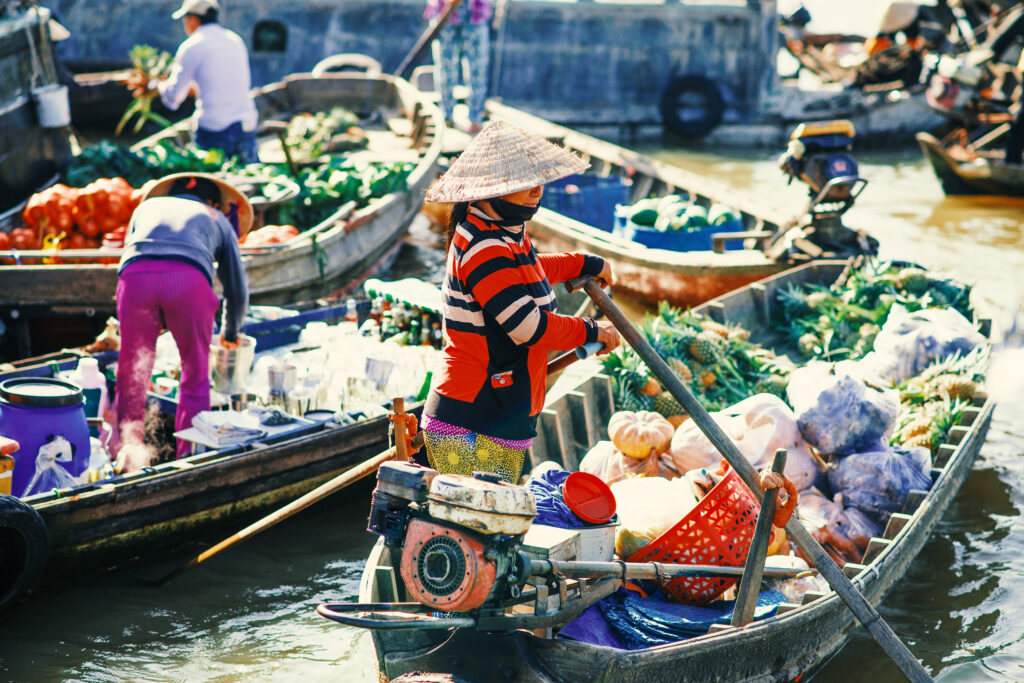
If you’re planning to experience the vibrant floating markets in Vietnam, especially in the Mekong Delta, a few handy tips will ensure you make the most of your visit. These markets are an essential part of the region’s culture, and navigating them with the right knowledge will help you capture the best moments while staying comfortable and prepared.
Book an Early Tour
The best time to experience the floating markets is early in the morning, as the markets typically start bustling at sunrise. If your tour begins after 6:30 AM, you risk missing the prime trading hours, which offer the most authentic sights and interactions. Be sure to book a tour that leaves as early as possible to capture the lively essence of the market.
Check What the Tour Includes
Not all floating market tours are created equal. Before booking, ask about the specifics of the tour. Some trips might only take you to Cai Rang, one of the more popular markets, while others may offer a more immersive experience, taking you through smaller waterways and lesser-known spots like Phong Dien. The more comprehensive the tour, the richer your experience will be.
Be Wary of Touts on the Waterfront
While booking a tour directly from the riverbank might seem convenient, be cautious. Many touts don’t speak English and may place you in a large boat crowded with other tourists, which can make for a less intimate experience. Opt for smaller group tours or even better, a sampan (a traditional wooden boat). These smaller vessels allow you to get closer to the action, providing a more authentic and personal experience.
Ensure Your Boat Has a Roof
Weather in the Mekong Delta can be unpredictable, with sudden rain showers being common. Make sure your boat is equipped with a roof or cover to avoid getting drenched in a surprise storm. Even if it doesn’t rain, the roof will offer essential protection from the hot sun.
Wear Comfortable and Lightweight Clothing
Since you’ll likely be sitting on a boat for extended periods, choose lightweight, loose-fitting clothing to ensure you’re comfortable and can move easily. The humid weather in the delta means you’ll want to stay cool and avoid heavy or restrictive clothing.
Choose Footwear Wisely
Wear sports shoes or sandals that are easy to move in. Boarding and disembarking from boats can be tricky, and you’ll need sturdy footwear to keep your footing on the sometimes slippery surfaces.
Bring Sun Protection
A wide-brimmed hat, sunscreen, and even an umbrella are essential to protect yourself from the intense sun. Weather can be unpredictable, so an umbrella will serve double duty in shielding you from sudden rain showers.
Carry Essential Supplies
The Mekong Delta is an adventure, but it’s always wise to be prepared. Carry medications, including remedies for stomach aches, as well as insect bite relief. Sunscreen and insect repellent are must-haves to keep your skin safe from the tropical sun and bugs.
By following these tips, you can ensure a safe, comfortable, and enriching experience at the floating markets in the Mekong Delta, leaving you with unforgettable memories of Vietnam’s unique river culture.
Most Famous Floating Markets in Vietnam
Cai Rang Floating Market

Address: Downstream of Can Tho River, 46 Hai Ba Trung Street, Ninh Kieu District, Can Tho City
Cai Rang Floating Market, located in Can Tho City, is one of the most iconic floating markets in Vietnam, with a history that spans over a century. Originally formed out of necessity when river trade was the primary means of commerce, Cai Rang has since become a bustling hub, attracting both locals and tourists. Just 30 minutes by boat from Ninh Kieu Wharf, the market remains a vibrant cultural experience, even as modern transportation has developed.
The market is renowned for its fleet of brightly colored boats, overflowing with fresh produce like bananas, pineapples, and watermelon. Traders gather as early as 5:30 a.m., creating a lively scene where visitors can buy fruits, vegetables, household items, and local handicrafts. The Beo poles, hanging with samples of goods, are a distinctive feature, making it easy for buyers to identify what’s being sold.
Cai Rang has been recognized as one of the top 10 most impressive markets globally due to its tropical vibrancy. In addition to shopping, visitors can enjoy Southern Vietnamese delicacies such as pho, hu tieu, and banh mi, served right on the boats. Even celebrity chef Gordon Ramsay was captivated by the market’s charm during his visit in 2013, where he sampled local noodle soup that left a lasting impression.
A visit to Cai Rang Floating Market offers an authentic glimpse into the Mekong Delta’s culture and the traditional way of life on the water.
Cai Be Floating Market
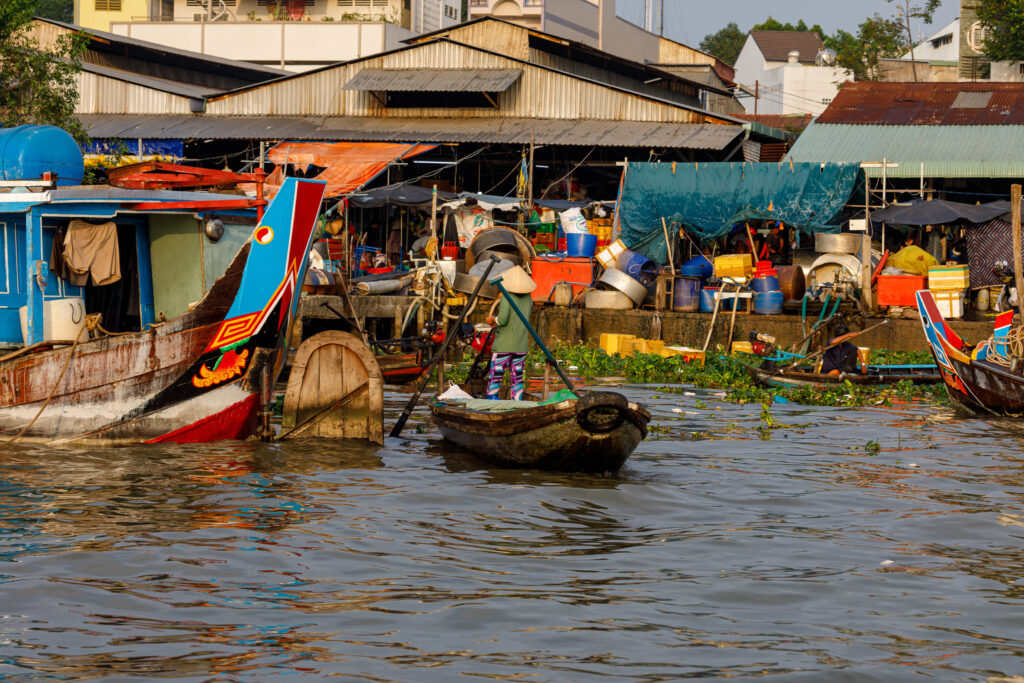
Address: Cai Be Town, Cai Be District, Tien Giang Province, about 45 kilometers west of the city center of My Tho.
Centuries-old and rich in tradition, Cai Be Floating Market in Tien Giang Province is one of the most culturally significant floating markets in Vietnam. Established during the 17th and 18th centuries, when Vietnamese immigrants began settling in the Southwest region, the market showcases the dynamic and creative spirit of those living along the rivers. Today, it remains one of the largest floating markets in Southeast Asia, drawing both locals and tourists to experience its lively trade and unique cultural features.
Cai Be’s floating market has long been a hub of activity, where vendors in brightly painted boats gather to sell a variety of fresh fruits, vegetables, and local products. The market comes to life at the crack of dawn, and the vibrant sight of boats filled with tropical produce creates an unforgettable scene. Cai Be has not only served the region’s trading needs but also become a premier tourist destination, heavily featured in travel itineraries across the Mekong Delta.
One of the most intriguing aspects of Cai Be Floating Market is its annual Mud Bath Festival, a signature event that adds an element of fun and tradition to the market experience. Celebrated during the Mid-Year Festival, the mud bath takes place from 1 p.m. to 4 p.m., when the river waters recede. Both locals and tourists eagerly plunge into the mud, believing that this joyful activity not only cleanses the body but also purges negative energy and brings good luck.
The festive atmosphere during the mud bath is contagious, with laughter, cheers, and excitement filling the air. This unique festival is a highlight of the Cai Be experience, making the floating market not just a place of commerce but a cultural event that embodies the lively and spirited character of the Mekong Delta. Whether you’re shopping for fresh produce, observing the vibrant trade, or joining the fun of the mud bath, Cai Be offers a truly immersive experience in the heart of Vietnam’s river life.
Long Xuyen Floating Market
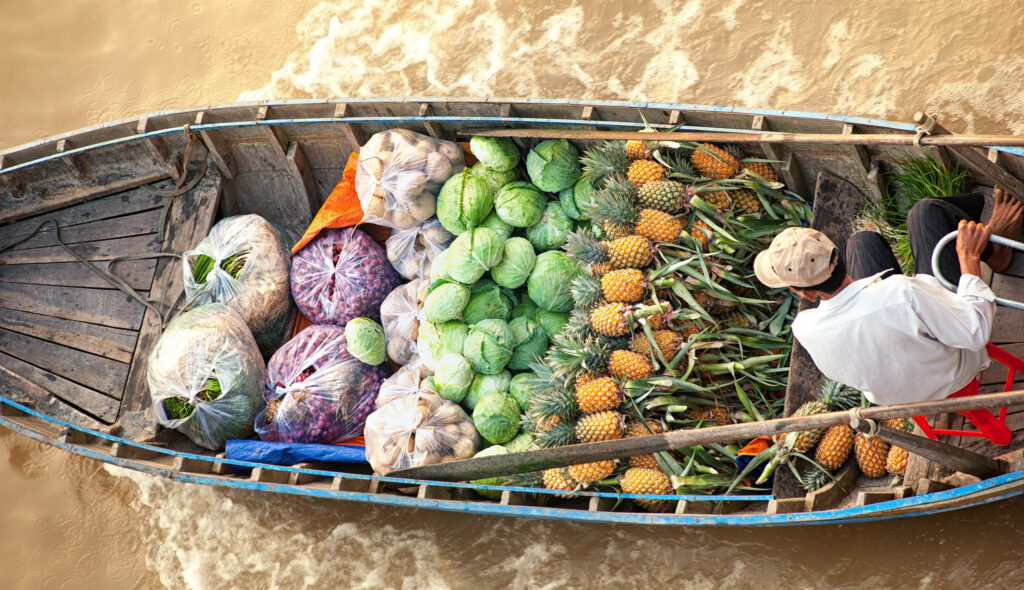
Address: My Phuoc Commune, Long Xuyen City, An Giang Province
Nestled on the Hau River near the heart of Long Xuyen City, Long Xuyen Floating Market is one of the lesser-known gems among the floating markets in Vietnam, yet it offers an authentic and peaceful experience. Located in An Giang Province, this market has been a vital part of the local culture for generations. Despite the development of modern road networks, Long Xuyen Floating Market has retained its traditional charm and remains an essential destination for anyone visiting the Mekong Delta.
Stretching about 2 kilometers from O Moi Ferry along the Hau River, the market is quieter and less commercialized compared to its counterparts like Cai Rang, making it an excellent choice for travelers looking for a more laid-back and intimate experience. The market comes alive at dawn, with the best time to visit being around 5 a.m., when the air is still cool with the morning dew, and the river awakens with activity.
One of the highlights of visiting Long Xuyen Floating Market is witnessing the breathtaking sunrise over the river. As the sun rises, hues of pink and orange spread across the sky, creating a beautiful backdrop for the market’s activities. The sight of boats drifting along the river, laden with fruits, vegetables, and other goods, paints a picture of a daily life that has remained unchanged for centuries.
Motorboats are readily available to take visitors through the market, allowing them to explore every corner and interact with the friendly vendors. Here, you’ll not only find local produce but also have the chance to engage with the warm-hearted people of An Giang, whose lives are deeply intertwined with the river.
For those seeking a quieter, more serene alternative to the larger floating markets, Long Xuyen offers an authentic taste of the Mekong Delta’s river culture, where the simplicity and rhythm of life on the water come to the forefront. The market may not be as crowded or commercialized, but that’s exactly what makes it special—a genuine slice of the river-based lifestyle that has shaped the region for generations.
Nga Bay Floating Market
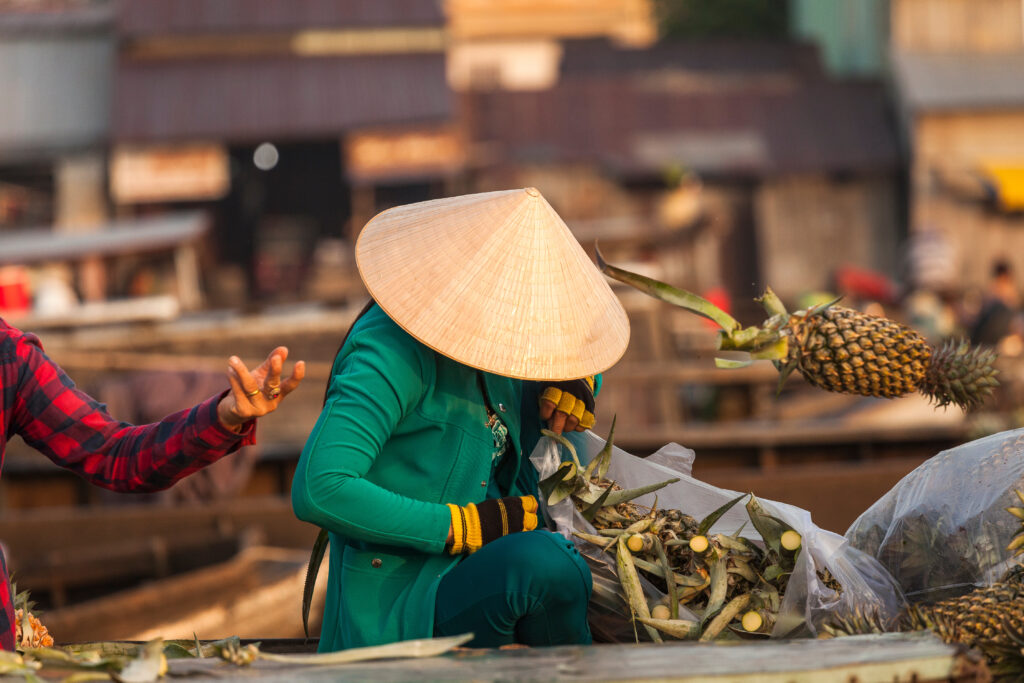
Address: Phung Hiep Bridge, Nga Bay Town, Hau Giang
Renowned for its bustling atmosphere, Nga Bay Floating Market (also known as Phung Hiep Floating Market) is one of the most famous floating markets in Vietnam. Located in the town of Nga Bay in Hau Giang Province, this vibrant market has been a cultural and commercial hub for more than a century, representing the essence of the Mekong Delta’s river life.
Established in the early 20th century, the floating market holds the soul of the river, preserving the customs, traditions, and economic culture of the local people. It is not only a place for trading goods but also a connection to the ancestors who once traversed the same waterways. The market serves as a living link between the past and present, where spirituality and commerce blend seamlessly, embodying the spirit of the entire Mekong region.
Nga Bay Floating Market has gained international attention and is often featured in travel guidebooks, making it a must-visit destination for tourists. The market typically opens at around 3:00 AM, and by the time the sun rises, hundreds of boats of various sizes gather, creating a lively scene. The best time to experience the full vibrancy of the market is in the early morning when the mist is still settling over the water, and the bustling activity begins.
This market primarily functions as a wholesale hub, specializing in fruits and agricultural products grown in the surrounding regions. Large quantities of goods are brought in daily, sorted by size and quality, and packed into cartons for distribution across Vietnam. Local farmers transport their products to the market on smaller boats, while larger vessels operated by traders distribute the goods to various parts of the country.
Visitors to the market can rent small boats at the ferry wharf, which usually accommodate 3-4 passengers, to explore the market’s vibrant trading activities. As you drift through the market, you’ll witness the colorful boats brimming with fruits like mangosteen, durian, and rambutan, and you’ll get a firsthand look at the lively commerce that keeps the Mekong Delta economy thriving.
Beyond the trade, Nga Bay Floating Market offers an intimate glimpse into the daily life of the locals. The hustle and bustle of boats, the vendors’ warm smiles, and the serene beauty of the river make for an unforgettable experience. Whether you’re there to witness the lively trade or immerse yourself in the rich cultural heritage, Nga Bay Floating Market is an essential stop on any Mekong Delta adventure.
Phong Dien Floating Market
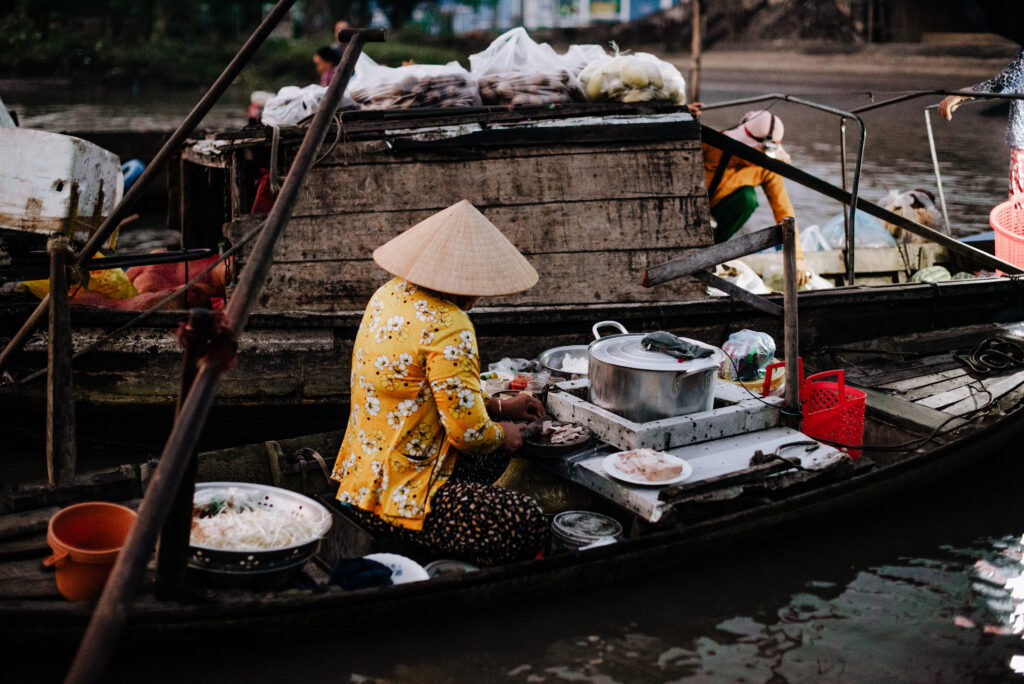
Address: Tay Do Bridge, Nhon Ai, Phong Dien District, Can Tho City
Phong Dien Floating Market is a charming and intimate marketplace, offering a more relaxed and authentic experience compared to the larger, busier markets like Cai Rang. Located around 20km southwest of Can Tho City, Phong Dien is less crowded, with fewer tourists, and showcases a quieter, more local flavor of the Mekong Delta’s floating market culture.
What makes Phong Dien Floating Market stand out is the predominance of traditional stand-up rowing boats, rather than motorized vessels. This slower-paced, more personal mode of transport allows local vendors to move around, chat, and exchange gossip while they sell their goods. The market is most active between 5:00 AM and 7:00 AM, so arriving early is key to witnessing its bustling activity. By late morning, much of the trading has wound down, leaving only a handful of boats behind.
Though Phong Dien is smaller than Cai Rang, it offers a more intimate experience where the boats are packed closely together, turning the market into a social gathering place, not just a commercial hub. Visitors can observe both the wholesale trade—carried out by larger boats—and smaller vendors in traditional rowing sampans who weave through the tight spaces, buying goods to sell in smaller, nearby canals.
Much like other floating markets in Vietnam, larger boats at Phong Dien display their goods using tall poles with products like fruits and vegetables hanging from the top, allowing buyers to easily identify what’s on sale from a distance. It’s an efficient and visually captivating system that reflects the resourcefulness of the local traders.
For those looking for a quieter, more authentic Mekong Delta experience, Phong Dien Floating Market offers the perfect blend of cultural immersion and local interaction. Many travelers opt for a combined Cai Rang–Phong Dien tour, allowing them to experience both markets in one morning, while returning to Can Tho through the serene backwaters of the Mekong. With its slower pace and community atmosphere, Phong Dien provides a peaceful yet engaging look into daily life on the river.
Nga Nam Floating Market
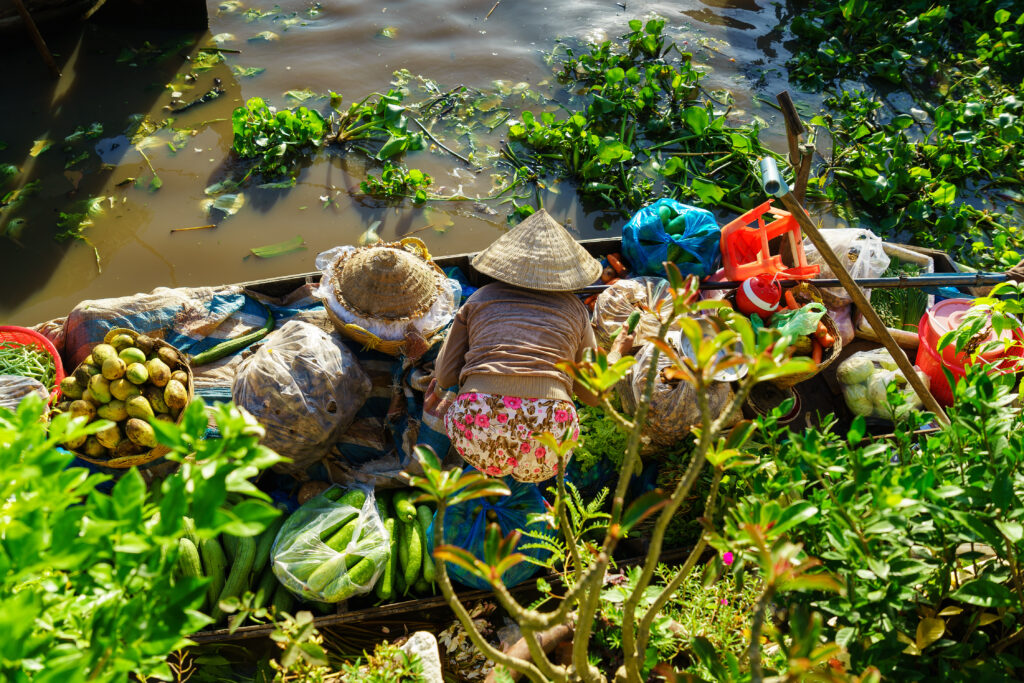
Address: Nga Nam Town, Soc Trang, Mekong Delta, Vietnam
Located in Soc Trang Province, Nga Nam Floating Market is a vibrant, colorful marketplace that brings the beauty and bustle of the Mekong Delta to life. The market’s unique name, “Nga Nam,” comes from its location at the intersection of five rivers, making it a strategic and lively hub for trade. At the right time, visiting this floating market feels like stepping into a vivid painting, with the vibrant colors of fruits and vegetables, the flowing traditional dresses of the women, and the boats of all shapes and sizes moving up and down the rivers.
One of the most striking features of Nga Nam Floating Market is its early start. Unlike many other markets, which open at dawn and operate through the morning, Nga Nam comes alive at 3-4 a.m., when the sky is still dark and the rivers are lit only by boat lanterns. By sunrise, the market is in full swing, bustling with the sounds of traders haggling and the smell of fresh produce filling the air. However, by 7-8 a.m., the market begins to wind down, with only a few boats remaining, ready to transport goods to neighboring regions.
Despite its growing popularity among tourists, Nga Nam Floating Market has retained its authentic charm and rustic feel. The simple way of life reflected in the trading habits, the friendly invitations from vendors rowing their boats, and the strong connection to the river’s natural rhythm all make this market a special destination. Here, you can witness a pure and unpretentious way of life, untainted by heavy commercialization.
Tra On Floating Market
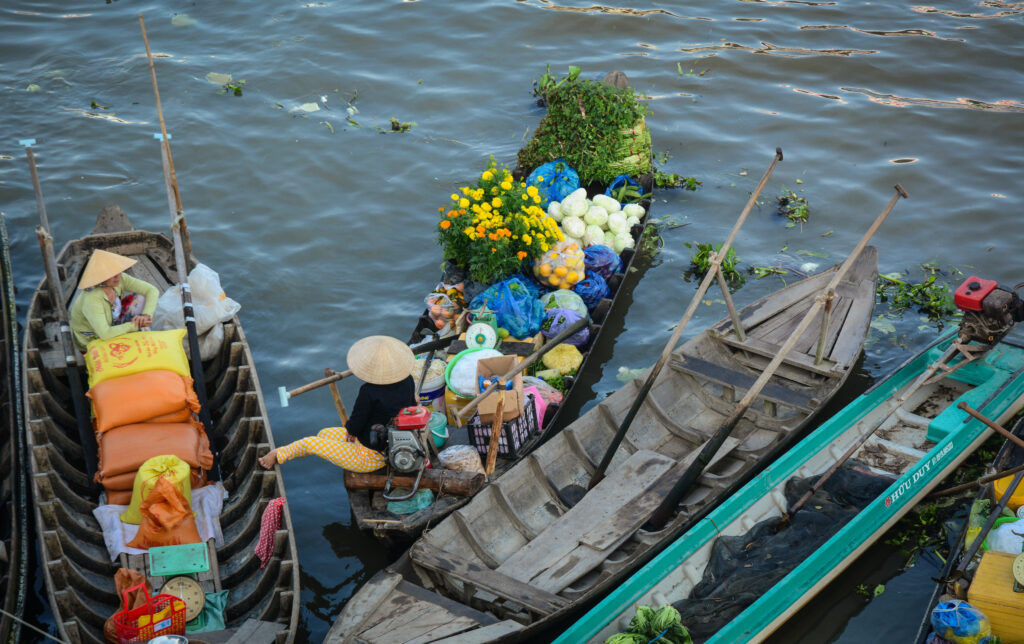
Address: Tra On District, Vinh Long Province
Positioned downstream on the Hau River, Tra On Floating Market is another vibrant example of the unique and traditional floating markets in Vietnam. Located just 250 meters away from the Tra On rivulet mouth in Vinh Long Province, the market spans over 300 meters and fluctuates in size depending on the coverage of the river’s surface. As the water level rises, the market becomes increasingly busy, with boats converging from various parts of the Mekong Delta.
Tra On Floating Market primarily operates as a wholesale market, specializing in agricultural products such as yams, cucumbers, bitter melon, and sweet potatoes. In addition to these, visitors will also find a bounty of fruits native to the region, such as Tan Thanh king oranges, Hoa Binh star apples, and Luc Si Thanh durians. The market is also known for its colorful and decorative flowers, adding a touch of beauty to the bustling scene of trade.
A true highlight of the Tra On Floating Market experience is the availability of the local specialty—hilsa fish. This beloved fish is prepared and processed in a variety of ways that can’t be found anywhere else, making it a must-try for anyone visiting the area.
Like other floating markets in the Mekong Delta, Tra On offers an authentic glimpse into the daily life of locals, showcasing the important role of river-based commerce. As visitors navigate through the lively maze of boats packed with fresh produce and flowers, they are treated to an immersive experience where the energy of the market, combined with the beauty of the river, creates an unforgettable atmosphere.
For those looking to explore the essence of river life in Vietnam, Tra On Floating Market is a must-visit destination. It captures the soul of the Mekong Delta, offering a mesmerizing mix of vibrant commerce, local delicacies, and the warm spirit of the people who call this region home.
Ca Mau Floating Market
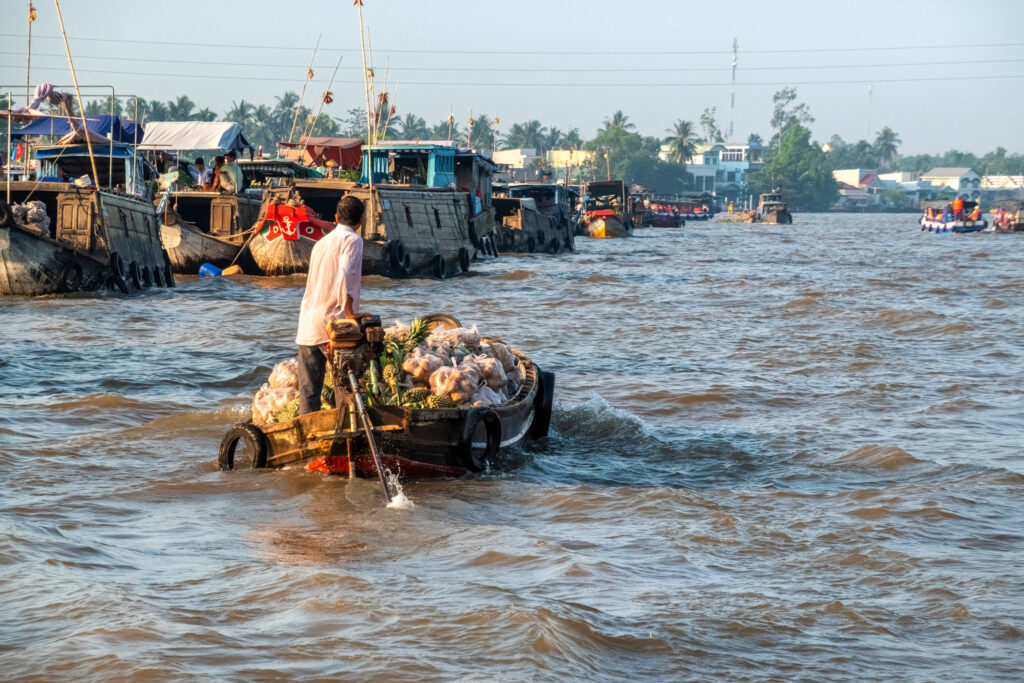
Address: Ward 7, Ca Mau Province
Located in the southernmost part of Vietnam, Ca Mau Floating Market is a vibrant and bustling center for trade and cultural exchange. Operating from the early hours of the morning, usually around 2 to 3 a.m., this floating market is a must-visit for those looking to experience the authentic river-based commerce that characterizes the Mekong Delta.
Ca Mau Floating Market offers a wide array of goods, ranging from daily necessities to agricultural products unique to the region. Visitors will find boats filled with fresh fruits like coconuts, mangoes, rambutans, and longans, all locally grown in the fertile lands of the Mekong Delta. These goods are traded directly on the boats, where local merchants offer their wares to both locals and tourists alike.
One of the most distinctive features of the Ca Mau Floating Market is the presence of the “rong” mats, a regional specialty that highlights the traditional craftsmanship of the area. These intricately woven mats are a testament to the resourcefulness and artistry of the local people, and they make for a unique souvenir or functional item.
Exploring the market by boat allows visitors to fully immerse themselves in the lively atmosphere of Ca Mau. The boats glide through the river, weaving between other vendors as you engage in friendly exchanges with the merchants. The experience is made even more memorable by the beautiful scenery of the river and the lively chatter of the market vendors.
Ca Mau Floating Market is more than just a place for trade—it’s a cultural experience that captures the essence of the Mekong Delta’s way of life. For anyone visiting this region of Vietnam, the market offers a rich and immersive opportunity to engage with local culture and traditions. Whether you’re there to buy fresh produce or simply to soak in the atmosphere, Ca Mau Floating Market promises a truly unforgettable experience.
Nam Can Floating Market
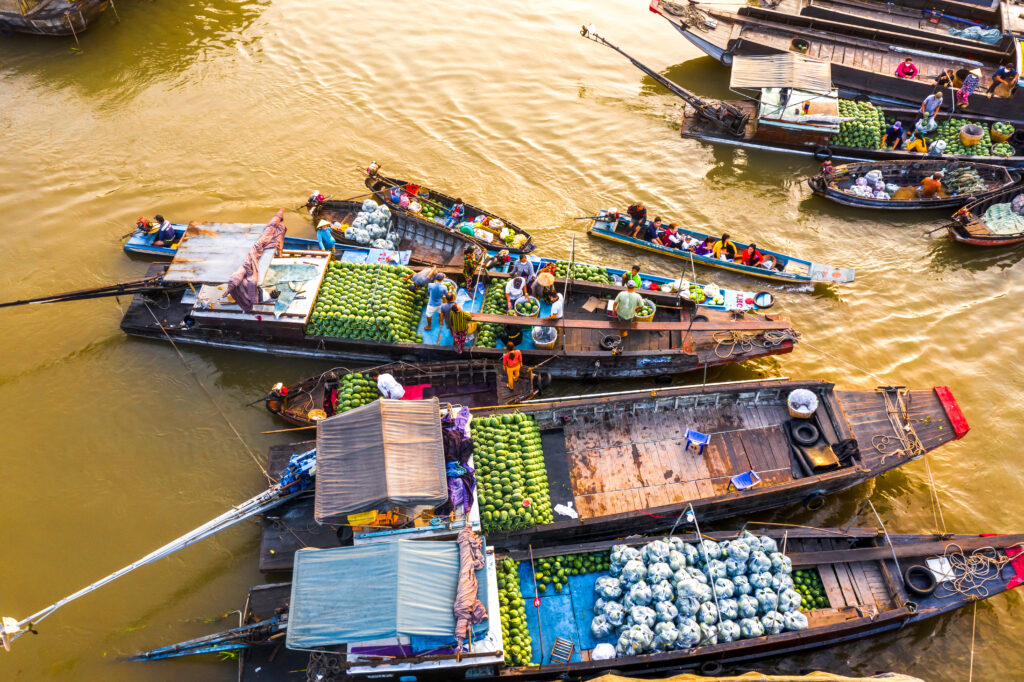
Address: Nam Can Town, Ca Mau Province
Known for its scenic beauty, Nam Can Floating Market stands out as one of the most picturesque floating markets in Vietnam’s Mekong Delta. Nestled in Nam Can Town, this bustling market offers an immersive experience into the vibrant river life of the region. From the early morning hours, boats of all sizes, filled with fresh agricultural produce, make their way to the market, creating a colorful and lively atmosphere on the water.
At Nam Can Floating Market, visitors will find a diverse array of goods ranging from fruits and vegetables to local delicacies. One of the market’s unique aspects is the availability of Ca Mau’s distinctive specialties, such as charcoal, traditional cakes, and freshly caught catfish. These items highlight the region’s rich natural resources and local craftsmanship, giving visitors a true taste of life in the Mekong Delta.
Each day, traders at Nam Can Floating Market not only cater to the needs of the local community but also play a vital role in distributing Ca Mau’s specialties to neighboring markets. The boats are loaded with fresh produce and unique items, which are then taken to other parts of the delta, ensuring the region’s rich resources are shared far and wide.
Exploring Nam Can Floating Market allows visitors to witness the daily rhythm of trade and life along the river. The friendly exchanges between vendors and the peaceful flow of the river create a serene yet lively experience that captures the essence of the Mekong Delta. Whether you’re there to purchase fresh local products or simply to enjoy the picturesque scene, Nam Can Floating Market offers a beautiful glimpse into one of Vietnam’s most unique cultural traditions.
Vinh Thuan Floating Market
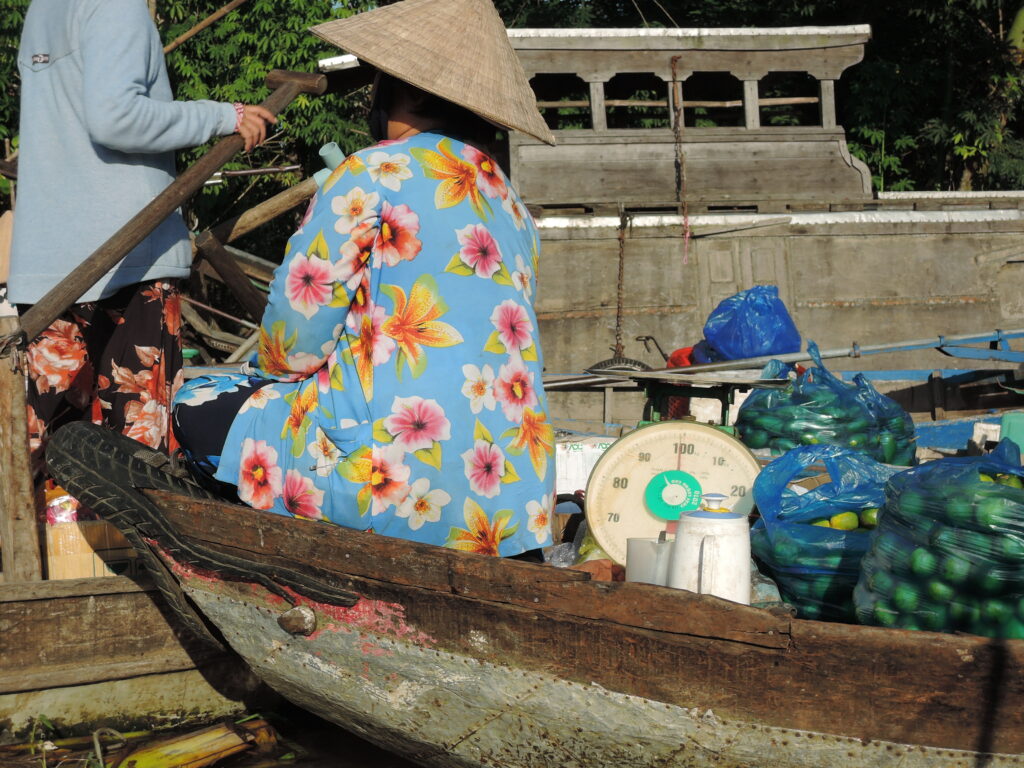
Address: Vinh Thuan District, Kien Giang Province
Located in Kien Giang Province, Vinh Thuan Floating Market is another vibrant example of the bustling river markets that define the floating markets in Vietnam. Like many other floating markets in the Mekong Delta, Vinh Thuan comes to life in the early morning hours, as local vendors converge on the river to trade their fresh produce. The market’s charm lies in its simplicity, offering a peaceful yet dynamic snapshot of daily life in the delta.
One of the highlights of visiting Vinh Thuan Floating Market is the opportunity to enjoy a meal while floating on the river. Visitors can hop on a traditional boat and indulge in local delicacies, such as the flavorful bun mam, a fermented fish noodle soup that is a favorite in the region. As you savor the dish, you can observe the bustling activity around you, with boats laden with fruits, vegetables, and other goods navigating the waterways.
What sets Vinh Thuan Floating Market apart is that many of the vendors are orchard owners who sell their own produce. This direct exchange between farmers and consumers ensures that the prices are reasonable and the goods are of the highest quality. From vibrant tropical fruits like mangoes and bananas to fresh greens and herbs, the market offers a wide array of agricultural products that reflect the region’s rich soil and favorable climate.
For travelers seeking an authentic glimpse into the local culture, Vinh Thuan Floating Market is a must-visit destination. Its serene atmosphere and focus on local produce create a more personal and intimate experience, making it a perfect stop on any Mekong Delta itinerary. Whether you’re shopping for fresh goods or simply enjoying the sights and sounds of the market, Vinh Thuan provides a beautiful snapshot of life on the river.
Best Things to Do at Floating Markets in Vietnam
Discovering the Intriguing Trading Method
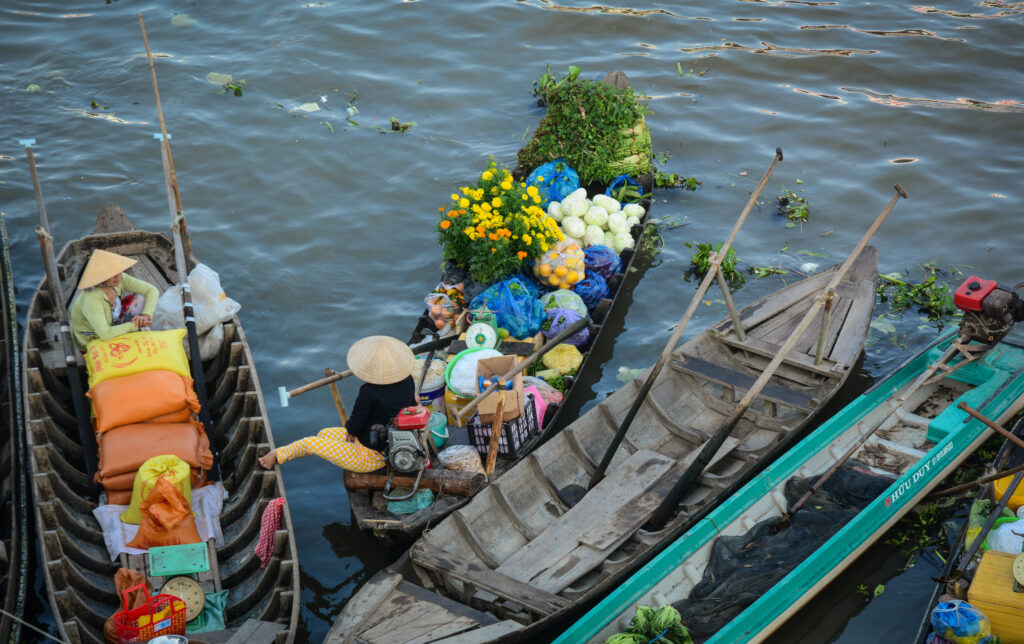
One of the most captivating aspects of floating markets in Vietnam is the unique way trading is conducted. At these bustling markets, the sounds of sellers calling out to advertise their goods can be drowned out by the vastness of the river and the noise of boat engines. This challenge led to a clever and highly effective advertising method: sellers hang their goods from the top of long bamboo poles, known as Beo trees, attached to their boats.
Every boat displays samples of its products—whether it’s fresh fruits, vegetables, or other goods—on these tall poles. This allows buyers to quickly identify what’s for sale from a distance, without needing to navigate through the entire market. All you have to do is look up, and you’ll know exactly which boat offers the goods you’re looking for. It’s an ingenious solution to the challenge of advertising on the water, and it’s a hallmark of the merchant business culture at these floating markets.
While floating from boat to boat, visitors can also enjoy the scenery of life along the river. As you pass by houses built on stilts over the water, and boats of all shapes and sizes docked along the shore, you’ll get a glimpse into the daily life of the Mekong Delta’s river communities.
Trying Local Food and Drinks
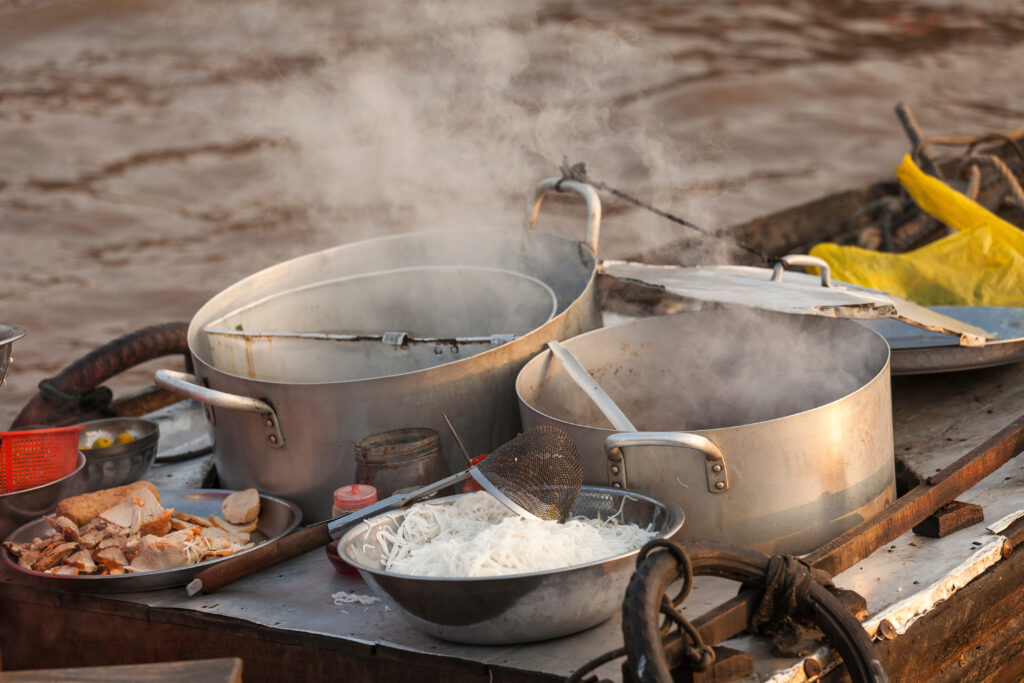
A visit to the floating markets in Vietnam wouldn’t be complete without sampling the local food and drinks on offer. These markets are not just hubs for buying goods—they’re culinary experiences in themselves. You’ll have the chance to try some of the freshest tropical fruits straight from nearby farms, including durian, milk fruit, rambutan, mangosteen, and grapefruit. Along with fresh produce, you can also find processed local specialties such as fish sauce, coconut candy, and dried fish.
Beyond fruits, the food boats serve up delicious traditional Vietnamese meals. Staples like com tam (broken rice with grilled pork), pho, hu tieu (rice noodle soup), and bun rieu (crab noodle soup) are available for as little as 25,000 VND (around 1 USD). There’s nothing quite like enjoying a steaming bowl of pho while floating on a river, surrounded by the lively atmosphere of the market. It’s the perfect way to immerse yourself in the local culture while indulging in authentic Vietnamese cuisine.
Enjoying Southern Vietnamese Folk Music (Đờn ca tài tử)
One of the highlights of visiting floating markets in Vietnam is the chance to enjoy live performances of Đờn ca tài tử, Southern Vietnamese folk music. Every weekend, boats filled with local artists sail along the river, serenading the market-goers with soulful melodies. This musical tradition is deeply connected to the lives of the people in the Mekong Delta, reflecting their emotions, work ethic, and strong community ties.
The gentle, soothing tones of Đờn ca tài tử provide the perfect soundtrack to your floating market experience, creating a peaceful yet vibrant atmosphere. It’s a special moment that captures the heart and soul of Southern Vietnamese culture, adding another layer to your visit to these iconic markets.
Experiencing the Bustling Market Life
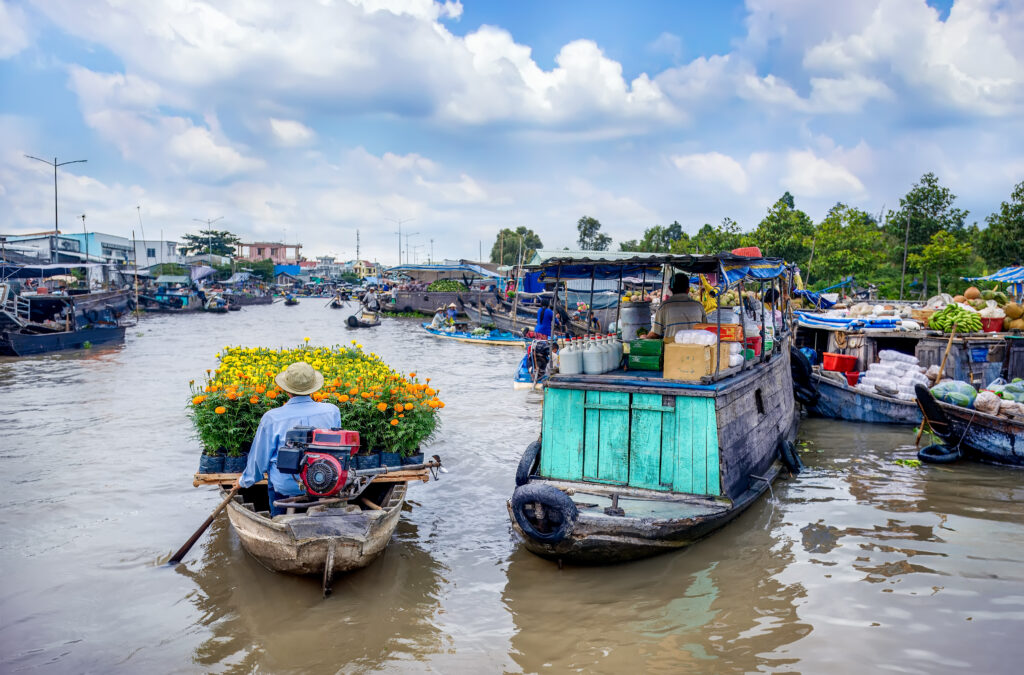
Beyond shopping and eating, a visit to the floating markets gives you a front-row seat to the lively and dynamic market culture. These markets are not only vital trading hubs, but they are also a social meeting place for local communities. You can observe the constant interactions between sellers and buyers, many of whom have traded at these markets for generations. Families often live on their boats, forming tight-knit communities that revolve around life on the water.
As you float through the market, you’ll also see how traders skillfully navigate their boats through the crowded waterways, exchanging goods with remarkable efficiency. This glimpse into daily life on the river reveals the deep connection the people of the Mekong Delta have with the water, making the floating market experience both a commercial and cultural adventure.
Taking a Boat Tour Along the Mekong River
To fully appreciate the beauty of the floating markets in Vietnam, consider taking a boat tour along the smaller canals and waterways of the Mekong Delta. These tours provide a serene escape from the busy markets, allowing you to explore the lush countryside and observe local life at a slower pace. As you drift through the narrow canals, you’ll pass by picturesque rice paddies, coconut groves, and traditional stilt houses, gaining a deeper understanding of the region’s natural and cultural landscape.
Buying Handicrafts and Souvenirs
In addition to food and agricultural products, many floating markets offer handcrafted goods made by local artisans. From woven baskets to embroidered textiles, these handicrafts are not only beautiful souvenirs but also a reflection of the traditional craftsmanship that thrives in the region. Purchasing a handmade item from a floating market supports the local economy and allows you to take home a piece of Vietnam’s vibrant culture.
Engaging with the Locals
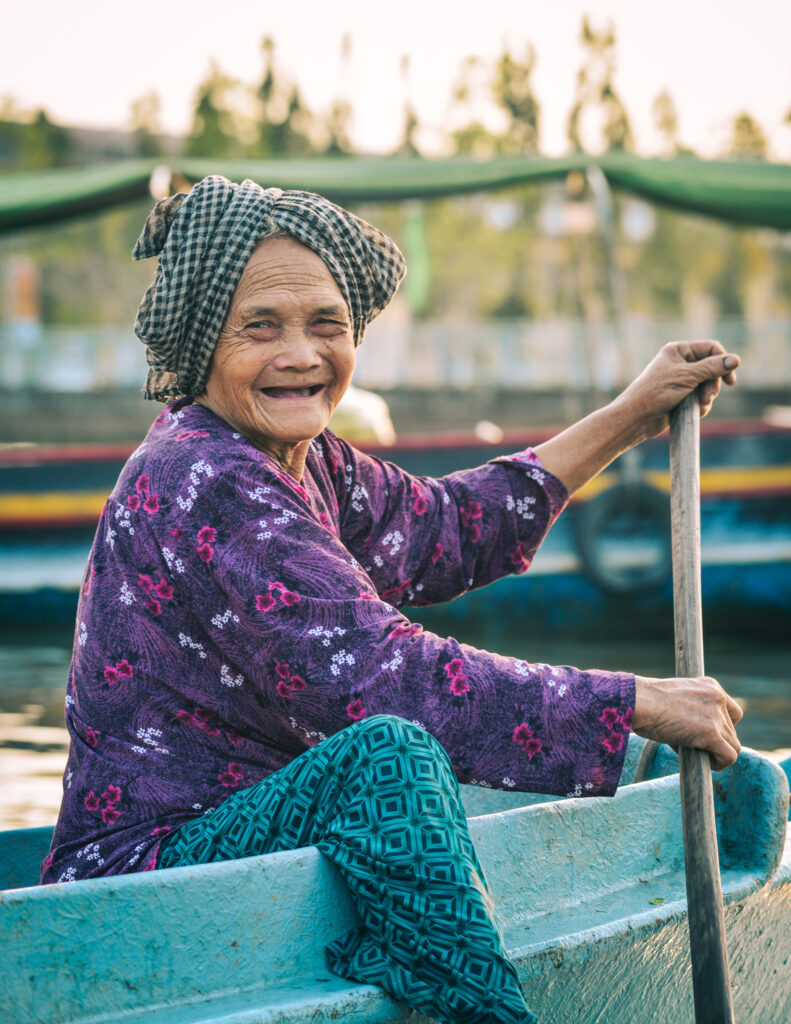
Interacting with the local sellers is another rewarding aspect of visiting the floating markets in Vietnam. Many vendors are incredibly welcoming and eager to share their stories, and even if there’s a language barrier, their warmth and hospitality shine through. Learning a few simple Vietnamese phrases can enhance your experience, helping you to connect with the people who call the Mekong Delta home. These interactions provide insight into the lives of those who rely on the floating markets for their livelihoods and offer a deeper connection to the community.
Photography Opportunities

For photography enthusiasts, floating markets in Vietnam offer a visual feast. The colorful boats, the bustling activity, and the lush backdrop of the Mekong Delta create endless opportunities for stunning photographs. Whether you’re capturing the vibrant fruit stalls, the intricate boat movements, or the scenic landscapes, the floating markets are a dream for anyone with a camera. The morning light reflecting off the water adds a magical touch to the scene, making it a perfect place for memorable snapshots.
By combining these experiences, your visit to the floating markets in Vietnam will be filled with unforgettable moments. From discovering traditional trading methods to indulging in local delicacies and engaging with the local community, the floating markets offer a unique blend of commerce, culture, and adventure.
Let’s Wrap It Up
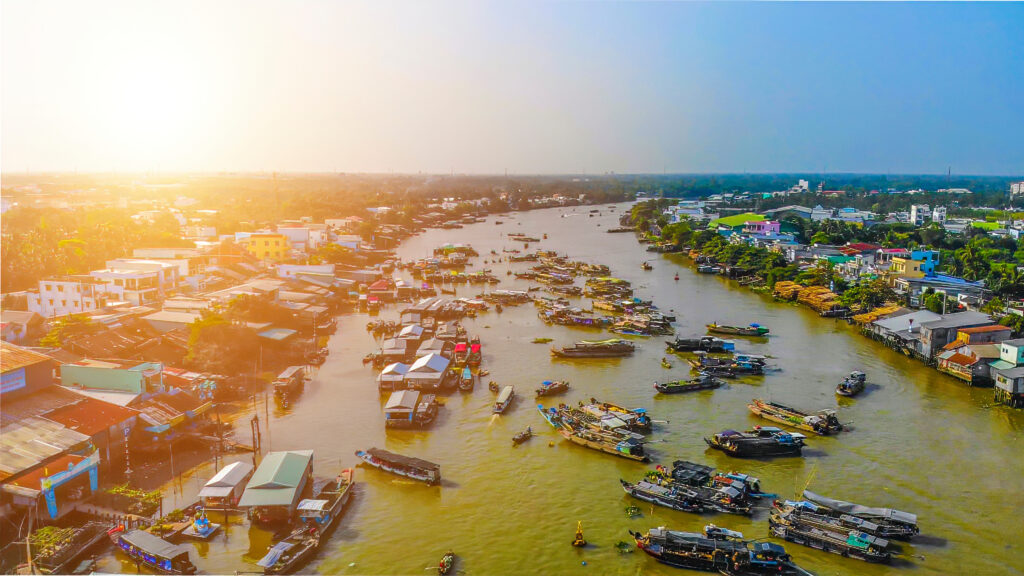
The floating markets in Vietnam are more than just bustling centers of commerce—they are living cultural treasures that showcase the vibrant river-based lifestyle of the Mekong Delta. Each market, from the famous Cai Rang to the more intimate settings of Vinh Thuan or Nam Can, offers a unique blend of local traditions, fresh produce, and a rich sense of community. Whether you’re tasting local delicacies, observing the lively trade of fruits and vegetables, or simply drifting along the waterways, these floating markets provide an authentic glimpse into the soul of Vietnam. For any traveler exploring the Mekong Delta, visiting these floating markets is an unforgettable experience that captures the charm, history, and rhythm of life along the river.
For more ways to explore Vietnam and its dynamic cities, check out our other articles:
- 25 unusual things to do in Ho Chi Minh
- 12 must-do tours in Ho Chi Minh
- 26 highlights in Ho Chi Minh’s Chinatown
- 20 Things To Do In Ho Chi Minh City At Night
- 25 Things to Do with Kids in Ho Chi Minh City
Ho Chi Minh City Cycling Tour In Ho Chi Minh City (Saigon) – Vietnam

At Jackfruit Adventure, we organize Ho Chi Minh City Cycling Tour and Team Building Ho Chi Minh. With a deep knowledge of Saigon city and local connections, we believe we can give you an awesome bonding time together. Contact us today if you have any requests or questions to prepare a trip for your team to bond in Ho Chi Minh – Vietnam.




